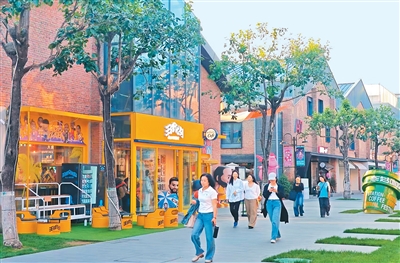




- BRNN
- BRI News
- BRNN News
- Database
Official Documents Polices and Regulations
Inter-government Documents International Cooperation BRI Countries
Business Guide Economic Data BRI Data
Trade
Investment Projects Latest projects
Cases - Content Pool
Beyond the confines of traditional department stores and shopping malls, many consumers are gravitating toward unconventional, creativity-driven commercial spaces that pulse with vitality and originality.
On a recent afternoon at Langyuan Station, just outside Beijing's east fifth ring road, visitors strolled past red-brick houses and sun-dappled greenery. The open-block layout sets the space apart: repurposed warehouses, railway tracks, station platforms and leafy courtyards blend seamlessly with a diverse collection of founder-led brand stores.

Photo shows visitors at Langyuan Station, outside the east fifth ring road in Beijing. (People's Daily Overseas Edition/Li Jie)
Once a textile storage facility, Langyuan Station began its transformation in 2019. Today, the sprawling complex has been reborn as a dynamic hub, drawing together the film and television industry, cafes, bookstores, art galleries, designer homeware shops, niche boutiques and music bars.
"This site was destined to become a nontraditional commercial project," said Zhao Chunyan, general manager of Beijing Capital Langyuan Culture Development Co., Ltd.
Nontraditional commercial spaces, a growing trend in China, break away from conventional retail models by emphasizing personalization and differentiation.
Data from Winshang, an industry information provider, shows that most nontraditional commercial projects launched in recent years are relatively small in scale, typically covering less than 50,000 square meters.
Even before these spaces attract widespread consumer attention, pioneering brand owners are often among the first to take notice.
At Langyuan Station, one such tenant is Ziinlife, a designer home decor brand. The store's facade retains the site's signature red-brick wall, while inside, a nine-meter-high ceiling has been reimagined as a two-level gallery. Visitors climb a wooden staircase to explore the brand's distinctive vision of modern home living.
"You can't create this kind of spatial experience in a traditional shopping mall," said Li Fei, the store manager. When Ziinlife had to relocate a few years ago, the team bypassed conventional malls, wary of high rents and large but untargeted crowds. After looking at nearly 20 parks across Beijing, they ultimately chose Langyuan Station.
Why are nontraditional commercial projects proliferating in China's urban spaces? One key driver is the larger wave of urban renewal. Many aging neighborhoods, abandoned industrial sites and underperforming shopping centers are in urgent need of revitalization. In July 2024, China's Ministry of Housing and Urban-Rural Development reported that more than 2,600 old factory areas and commercial blocks nationwide had already undergone renovation.
Winshang's data also indicates that nontraditional venues are particularly attractive to niche and individualized brands compared to traditional retail spaces. These settings naturally draw young consumers who share similar tastes and lifestyles with the brand owners, creating a distinctive cultural and visual community.
At Langyuan Station, for example, just 20 percent of the 104 commercial tenants are chain stores; the remaining 80 percent are independent or nontraditional brands.
One such tenant is Lao Ding Feng, a time-honored pastry brand from Harbin in northeast China's Heilongjiang Province. At Langyuan Station, the brand has reimagined its identity, presenting a fresh, contemporary face to visitors.
"We came in with the intent to do something different," said Dai Kun, marketing director at Beijing Lao Ding Feng Food Co., Ltd. The red brick and railway tracks at Langyuan Station resonated with Lao Ding Feng's drive for innovation. Today, this location serves not only as a retail outlet but also as the company's headquarters and R&D center in Beijing.
Compared with the brand's other Beijing locations, this one doesn't offer the best geography or foot traffic. Yet during this year's five-day May Day holiday, the store ranked among the top performers in sales across all its Beijing branches for several days.
Nontraditional commercial projects have also taken social media by storm, generating buzz with pop-up markets, events and exhibitions. But what's the secret to running them successfully over the long term?
"At Langyuan Station, our strategy is built on three pillars: industrial integration, community engagement and design-driven development," Zhao said. Zhao believes Langyuan Station's greatest strength is its integration of commerce and industry — where retail activity is supported by genuine industrial output, and commercial success helps drive further industrial growth.

Tel:86-10-65363107, 86-10-65368220, 86-10-65363106